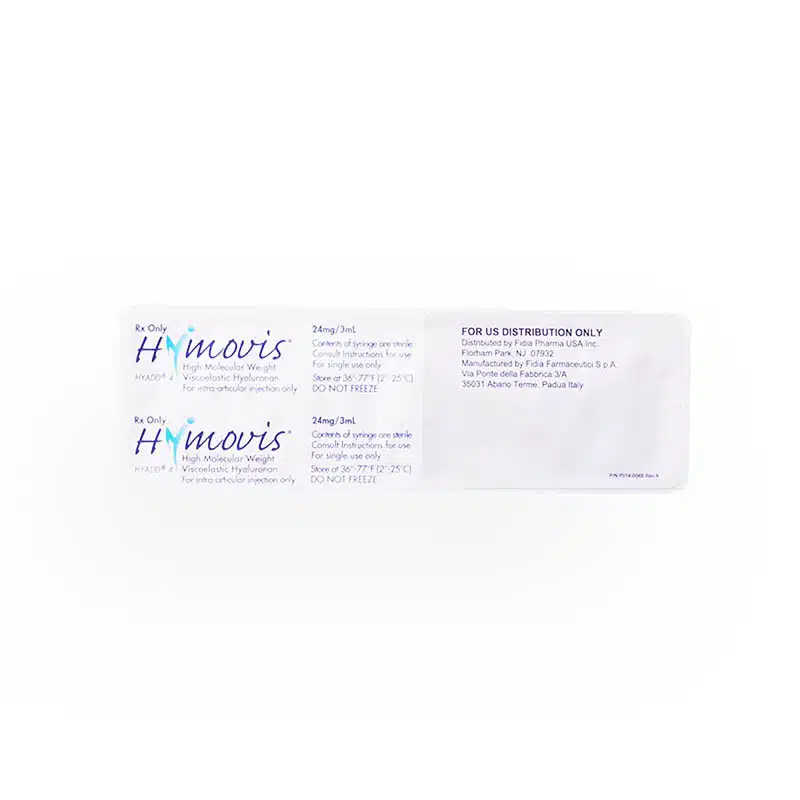Osteoarthritis (OA) is the most common form of arthritis, affecting millions of people worldwide. In 2020 alone, more than 595 million individuals were diagnosed with OA, and with aging populations and rising obesity rates, that number is expected to grow even further.
One promising treatment for knee osteoarthritis is Hymovis, a viscosupplement injection made from highly purified hyaluronic acid. Its purpose? To reduce pain and improve joint function by providing better lubrication and shock absorption inside the knee.
In this article, we’ll dive into the Hymovis dosing guidelines, key prescribing details, and what patients can expect during treatment.
Key Takeaways
- Hymovis is an injectable viscosupplement used to treat knee pain caused by osteoarthritis (OA) when other treatments like painkillers or physical therapy are not enough. It works by improving joint lubrication and providing better cushioning within the knee.
- The standard dosing involves two injections spaced one week apart. Each injection helps lubricate and cushion the knee joint, providing up to six months of pain relief.
- Hymovis must be administered by a trained healthcare professional using strict aseptic techniques to prevent contamination.
- Common side effects include localized pain, swelling, or redness at the injection site. Serious reactions, such as allergic responses, are rare but should be monitored.
- Hymovis is not recommended for patients with known allergies to hyaluronic acid or those with infections or severe joint inflammation.
About: Medical Spa RX provides medical practices with premium products at the best prices. If you’re looking to buy Hymovis for your practice, the sales representatives at Medical Spa RX can give you guidance.
Patient Selection and Indications for Hymovis
Hymovis is specifically designed for people dealing with knee pain caused by osteoarthritis (OA). It’s a great option for patients who need enhanced joint cushioning and better lubrication to help with daily movement and reduce discomfort. According to Hymovis injection reviews, the treatment has been shown to reduce pain and improve mobility for those suffering from OA, offering an effective solution when other options fall short.
This treatment works by injecting high-quality hyaluronic acid into the knee, which helps restore the joint’s natural viscoelasticity. This improves the overall function of synovial fluid, making the knee joint more flexible and less painful.
Recommended Dosing and Administration Technique
Hymovis is typically administered in a series of two injections, spaced one week apart. This dosing schedule is crucial to achieve the best possible results for reducing knee pain and improving joint function in patients with osteoarthritis (OA). Each injection contains 24 mg of hyaluronic acid in a pre-filled, sterile syringe, which is designed for single use only.
Administration Technique
For optimal results, the Hymovis injections must be administered by a trained healthcare professional following strict aseptic techniques. The injection should be delivered directly into the intra-articular space of the knee joint. Here’s a step-by-step breakdown of the administration:
- Preparation: The area around the knee is cleaned thoroughly to prevent infection.
- Needle Insertion: The healthcare provider inserts a sterile needle into thejoint space under precise guidance.
- Injection: Thehyaluronic acid is injected into the knee joint to enhance lubrication and shock absorption, making movement more comfortable and reducing pain.
The two-injection series is crucial for achieving the desired therapeutic effect. The first injection helps to initiate the treatment process, while the second injection, administered one week later, reinforces the initial dose, providing prolonged relief and improved joint function. Adhering to this schedule is essential for the effectiveness of the treatment.
Precautions, Assessments, and Contraindications
Before starting Hymovis treatment, it’s important to thoroughly understand the patient’s medical history and overall health. This includes checking for any allergies, especially to hyaluronic acid products, and evaluating the condition of the knee. In some cases, the doctor may suggest X-rays or MRIs to assess the joint’s damage and confirm the presence of osteoarthritis.
When administering Hymovis, keeping everything clean and sterile is essential to avoid infection. The injection site should be properly disinfected, and the healthcare professional must use sterile gloves and equipment.
The injection must be placed accurately into the joint space to ensure it works effectively. After the injection, patients should avoid heavy or strenuous activities for about 48 hours to give the medication time to settle and do its job.
Hymovis isn’t suitable for everyone. It should be avoided in patients with known allergies to hyaluronic acid or any of the injection’s ingredients. Additionally, the treatment should be postponed if there’s an infection or skin condition at the injection site. Patients with severe joint inflammation or bleeding disorders should also avoid Hymovis, as these conditions could increase the risk of complications.
Storage, Handling, and Safety Considerations
Proper storage and handling of Hymovis are key to maintaining its effectiveness and safety. It should be kept in a cool, dry place, ideally between 2°C and 25°C (36°F to 77°F), and away from direct sunlight.
It’s important to avoid freezing the product, and care should be taken to prevent it from exposure to excessive heat. Before administering, always check the solution for any unusual particles or discoloration to ensure it’s still safe to use.
For clinicians, safety is a priority when administering Hymovis. Strict aseptic techniques are necessary to prevent contamination during injections, and healthcare professionals must be well-versed in proper injection methods. This helps minimize any discomfort for the patient while reducing the likelihood of complications.
Potential Adverse Effects and How to Manage Them
Some common side effects include mild pain, swelling, or redness around the injection site, which typically go away after a short period. In rare cases, patients might experience allergic reactions. These are usually managed with simple remedies, such as applying ice to ease the swelling or taking pain relievers.
For more serious reactions, antihistamines or corticosteroids may be required. Patients should monitor any unusual symptoms and report them to their doctor right away to ensure timely care.
Conclusion
Hymovis offers effective relief for knee pain caused by osteoarthritis, mainly when other treatments fail. Two simple injections spaced a week apart improve joint lubrication, reducing discomfort and improving knee mobility. Many patients find it to be a safe and reliable option, offering long-lasting results.
If knee pain is affecting your quality of life, Hymovis could be worth considering as part of your treatment plan.
FAQs
1. What is Hymovis?
Hymovis is a gel-like injection that mimics the natural fluid in your knee joint, helping to ease pain and improve movement by adding lubrication and cushioning.
2. How long does the pain relief from Hymovis last?
After completing the two injections, most patients experience relief lasting about six months, making it a long-lasting option for knee pain management.
3. Are there any side effects I should be aware of?
The most common side effects are minor, like swelling or soreness at the injection site. However, if you experience anything unusual, like a severe allergic reaction, it’s important to get medical attention.
4. Can I get Hymovis if other treatments haven’t worked for me?
Hymovis is often recommended for people who haven’t had success with other treatments like pain medications or physical therapy.
References
Institute for Health Metrics and Evaluation. (n.d.). Lancet: New study reveals the most common form of arthritis. Retrieved October 11, 2024, from https://www.healthdata.org/news-events/newsroom/news-releases/lancet-new-study-reveals-most-common-form-arthritis
Munz K. New projections for the global burden of osteoarthritis through 2050. AJMC. https://www.ajmc.com/view/new-projections-for-the-global-burden-of-osteoarthritis-through-2050. Published August 22, 2023.
Migliore, A., Frediani, B., Gigliucci, G., Foti, C., Crimaldi, S., De Lucia, O., & Iolascon, G. (2020). Efficacy of a Single Intra-Articular HYMOVIS ONE Injection for Managing Symptomatic Hip Osteoarthritis: A 12-Month Follow-Up Retrospective Analysis of the ANTIAGE Register Data. Orthopedic research and reviews, 12, 19–26. https://doi.org/10.2147/ORR.S239355






















